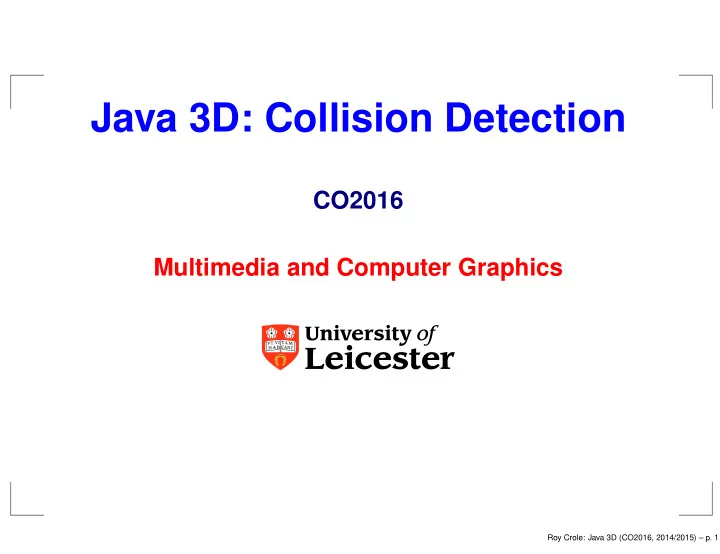

Java 3D: Collision Detection CO2016 Multimedia and Computer Graphics Roy Crole: Java 3D (CO2016, 2014/2015) – p. 1
Wake-Up Conditions and Criteria WakeUpCondition is an abstract class specifying a single wakeup Condition. It has a subclass called WakeupCriterion . . . . . . and it has subclasses called WakeupOr , WakeupAnd (and others . . . ). The class WakeUpCriterion has subclasses WakeUpOnExit , WakeUpOnEntry (and others . . . ). These wake up criteria can be logically combined: WakeupOr ( [ WakeUpOnExit , WakeUpOnEntry ] ) � �� � WakeupCriterion arrayof Roy Crole: Java 3D (CO2016, 2014/2015) – p. 2
The Behavior Class A Behavior leaf node in a scene graph allows the addition of user-defined “actions” to the scene graph, for example: movements, rotations, color changes . . . Behavior is an abstract class; it defines two methods that must be over-ridden (see CollisionBehavior1 ) by a subclass: Initialization method: called once when the behavior becomes "live". Sets the initial state of a Behavior object, and specifies its initial wakeup condition(s). processStimulus method: This is the important method . . . Roy Crole: Java 3D (CO2016, 2014/2015) – p. 3
The Behavior Class A Behavior leaf node hands a WakeupCondition object to the behavior scheduler which returns criteria , an enumeration ( Enum ) of the conditions. criteria is produced by the wakeupOn method. The processStimulus method provides: Code to extract wake up details, from criteria , that caused the object’s awakening. Code to perform the manipulations associated with the wake up details (eg a green sphere goes red), Code to establish this behavior’s next new WakeupCondition Roy Crole: Java 3D (CO2016, 2014/2015) – p. 4
Recommend
More recommend